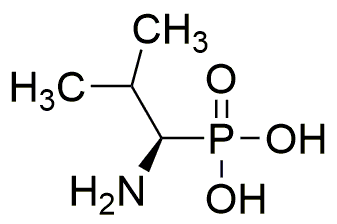(1R)-(+)-(1-Amino-2-methylpropyl)phosphonic acid is widely utilized in research focused on
- Agriculture: This compound acts as a plant growth regulator, enhancing crop yields and improving resistance to environmental stressors. It is particularly beneficial in promoting root development and overall plant health.
- Pharmaceuticals: It serves as a key intermediate in the synthesis of various pharmaceutical agents, especially those targeting neurological disorders. Its unique structure allows for the development of drugs with improved efficacy and reduced side effects.
- Biochemistry: Researchers use this compound in studies related to amino acid metabolism and phosphonate chemistry, providing insights into metabolic pathways and potential therapeutic targets.
- Food Industry: It can be utilized as a food additive to enhance nutritional profiles, particularly in fortified foods, by contributing essential amino acids and phosphonic compounds.
- Environmental Science: The compound is explored for its potential in bioremediation processes, aiding in the detoxification of contaminated soils and waters through its interaction with heavy metals and other pollutants.
General Information
Properties
Safety and Regulations
Applications
(1R)-(+)-(1-Amino-2-methylpropyl)phosphonic acid is widely utilized in research focused on
- Agriculture: This compound acts as a plant growth regulator, enhancing crop yields and improving resistance to environmental stressors. It is particularly beneficial in promoting root development and overall plant health.
- Pharmaceuticals: It serves as a key intermediate in the synthesis of various pharmaceutical agents, especially those targeting neurological disorders. Its unique structure allows for the development of drugs with improved efficacy and reduced side effects.
- Biochemistry: Researchers use this compound in studies related to amino acid metabolism and phosphonate chemistry, providing insights into metabolic pathways and potential therapeutic targets.
- Food Industry: It can be utilized as a food additive to enhance nutritional profiles, particularly in fortified foods, by contributing essential amino acids and phosphonic compounds.
- Environmental Science: The compound is explored for its potential in bioremediation processes, aiding in the detoxification of contaminated soils and waters through its interaction with heavy metals and other pollutants.
Documents
Safety Data Sheets (SDS)
The SDS provides comprehensive safety information on handling, storage, and disposal of the product.
Product Specification (PS)
The PS provides a comprehensive breakdown of the product’s properties, including chemical composition, physical state, purity, and storage requirements. It also details acceptable quality ranges and the product's intended applications.
Certificates of Analysis (COA)
Search for Certificates of Analysis (COA) by entering the products Lot Number. Lot and Batch Numbers can be found on a product’s label following the words ‘Lot’ or ‘Batch’.
*Catalog Number
*Lot Number
Certificates Of Origin (COO)
This COO confirms the country where the product was manufactured, and also details the materials and components used in it and whether it is derived from natural, synthetic, or other specific sources. This certificate may be required for customs, trade, and regulatory compliance.
*Catalog Number
*Lot Number
Safety Data Sheets (SDS)
The SDS provides comprehensive safety information on handling, storage, and disposal of the product.
DownloadProduct Specification (PS)
The PS provides a comprehensive breakdown of the product’s properties, including chemical composition, physical state, purity, and storage requirements. It also details acceptable quality ranges and the product's intended applications.
DownloadCertificates of Analysis (COA)
Search for Certificates of Analysis (COA) by entering the products Lot Number. Lot and Batch Numbers can be found on a product’s label following the words ‘Lot’ or ‘Batch’.
*Catalog Number
*Lot Number
Certificates Of Origin (COO)
This COO confirms the country where the product was manufactured, and also details the materials and components used in it and whether it is derived from natural, synthetic, or other specific sources. This certificate may be required for customs, trade, and regulatory compliance.


